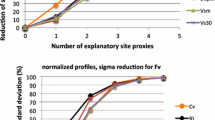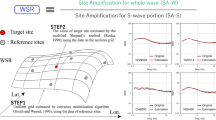Abstract
Based on the quarter-wavelength approximation, the frequency-dependent site amplifications, A(f ), at 18 free-field strong-motion stations in and near the Taipei Basin are evaluated from well-logging data. The V 30, which is the average of the S-wave velocities in the topmost 30 m, is a significant factor in classifying the sites. Results show that the site amplifications at all sites in study are larger than 1 and functions of frequency. Compared with the Haskell method, the quarter-wavelength approximation is almost an average and a good representation of overall amplifications. It is noted that the site amplifications evaluated in this study can apply only to frequencies greater than about 1.1 Hz for class C sites and 3.1 Hz for class D.
Similar content being viewed by others
References
Atkinson GM, Cassidy JF (2000) Integrated use of seismograph and strong- motion data to determine soil amplification: response of the Fraser River Delta to the Duvall and Georgia Strait earthquake. Bull Seismol Soc Am 90:1028–1040. doi:10.1785/0119990098
Boore DM, Joyner WB (1997) Site amplifications for generic rock sites. Bull Seismol Soc Am 87:327–341
CGS (Central Geological Survey) (1999) Subsurface geology and engineering environment of the Taipei Basin. Special Pub. 11, Central Geol. Survey, Ministry of Economic Affairs, ROC, 406 pp (in Chinese)
Chen KC (2003) Strong ground motion and damage in the Taipei Basin from the Moho reflected seismic waves during the March 31, 2002, Hualien, Taiwan, earthquake. Geophys Res Lett 30(11):1551. doi:10.1029/2003GL017193
Day SM (1996) RMS response of a one-dimensional half space to SH. Bull Seismol Soc Am 86:363–370
Fletcher JB, Wen KL (2005) Strong ground motion in the Taipei basin from the 1999 Chi-Chi, Taiwan, Earthquake. Bull Seismol Soc Am 95:1428–1446. doi:10.1785/0120040022
Haskell NA (1960) Crustal reflection of plane SH waves. J Geophys Res 65:4147–4150. doi:10.1029/JZ065i012p04147
Hsu MT (1961) Seismicity of Taiwan (Formosa). Bull Earthq Res Inst Univ Tokyo 39:831–847
Hsu H (1983a) Source materials on the history of natural disasters in Ching Taiwan. Hazards Mitig Sci Technol Rep 72–01:5–6
Hsu H (1983b) Estimation of earthquake magnitudes and seismic intensities of destructive earthquakes in the Ming and Ching Eras. Meteorol Bull 29(4):1–18 (in Chinese)
Huang MW, Wang JH, Hsieh HH, Wen KL, Ma KF (2005) Frequency-dependent sites amplifications evaluated from well-logging data in central Taiwan. Geophys Res Lett 32:L21302. doi:10.1029/2005GL023527
Huang MW, Wang JH, Ma KF, Wang CY, Hung JH, Wen KL (2007) Frequency-dependent site amplifications with f ≥ 0.01 Hz evaluated from velocity and density models in central Taiwan. Bull Seismol Soc Am 97(2):624–637. doi:10.1785/0120060139
Joyner WB, Warrick RE, Fumal TE (1981) The effect of Quaternary alluvium on strong ground motion in the Coyote Lake, California, earthquake of 1979. Bull Seismol Soc Am 71:1333–1349
Klimis NS, Margaris BN, Koliopoulos PK (1999) Site-dependent amplification functions and response spectra in Greece. J Earthqu Eng 3(2):237–270. doi:10.1142/S1363246999000107
Lee CT, Cheng CT, Liao CW, Tsai YB (2001) Site classification of Taiwan free-field strong-motion stations. Bull Seismol Soc Am 91:1283–1297. doi:10.1785/0120000736
Lermo J, Chávez-García FJ (1993) Site effect evaluation using spectral ratios with only one station. Bull Seismol Soc Am 83:1574–1594
Ma KF, Wang JH, Zhao D (1996) Three-dimensional seismic velocity structure of the crust and uppmost mantle beneath Taiwan. J Phys Earth 44:85–105
Malagnini LK, Mayeda LK, Akinci A, Bragato PL (2004) Estimating absolute site effects. Bull Seismol Soc Am 94:576–590. doi:10.1785/012003161
Teng LS, Wang SC, Chang CB, Hsu C, Yuan PB, Chen PY (1994). Quaternary strata frame of the Taipei basin. Proc. joint symposium on Taiwan quaternary (5) and on investigation of subsurface geology/engineering environment of Taipei Basin, pp 129–135 (in Chinese)
Tzou YH, Yu GK (1987) Subsurface structure of the Tatun volcano group area inferred from the gravity data. Bull Geophys Natl Cent Univ 27/28:45–60
Wang JH (1998) Studies of earthquake seismology in Taiwan during the 1897–1996 period. J Geol Soc China 41:291–336
Wang CY, Lee YH, ChangHC (1996) P- and S-wave velocity structures of the Taipei basin. In: Symposium on Taiwan strong motion instrumentation program (II). Central Weather Bureau, pp 171–177
Wang CY, Lee YH, Ger ML, Chen YL (2004) Investigating subsurface structures and P- and S-wave velocities in the Taipei Basin. Terr Atmos Ocean Sci 14:609–628
Wang-Lee CM, Lin TP (1987) The geology and land subsidence of the Taipei Basin. Mem Geol Soc China 9:447–464
Wen KL, Peng HY (1998) Site effect analysis in the Taipei Basin: results from TSMIP network data. Terr Atmos Ocean Sci 9(4):691–704
Wen KL, Fei LY, Peng HY, Liu CC (1995a) Site effect analysis from the records of the Wuku downhole array. Terr Atmos Ocean Sci 6(2):285–298
Wen KL, Peng HY, Liu LF, Shin TC (1995b) Basin effects analysis from a dense strong motion observation network. Earth Eng Struct Dynam 24(8):1069–1083. doi:10.1002/eqe.4290240803
Zhang F (2004) Site response and attenuation analysis using strong motion and short-period data. Ph.D. Dissertation, Dept Civil Struct Environ Eng, SUNY-Buffalo, 278 pp
Author information
Authors and Affiliations
Corresponding author
Rights and permissions
About this article
Cite this article
Huang, MW., Wang, JH., Hsieh, HH. et al. High frequency site amplification evaluated from Borehole data in the Taipei Basin. J Seismol 13, 601–611 (2009). https://doi.org/10.1007/s10950-009-9153-3
Received:
Accepted:
Published:
Issue Date:
DOI: https://doi.org/10.1007/s10950-009-9153-3




